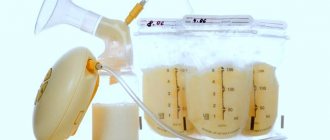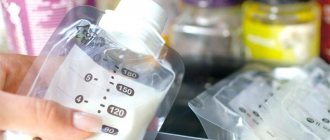Breast milk is a mixture of the most important nutrients a baby needs to support the immune system, full growth, and development of all organs and body systems. Also, when breastfeeding, a personal, unique connection arises between a mother and her baby, which then lasts a lifetime.
All foods that a nursing woman eats become food for her baby. The food is broken down into individual components, and after a short period of time passes through the milk to the baby, becoming a healthy treat for the smallest member of the family.
Each product needs a different time period to become milk; it is unlikely that a couple of minutes after the mother eats, the child will receive any useful substances.
When breastfeeding, there are certain restrictions on the food the mother eats, for example, this applies to alcohol, medications, and foods that cause allergies. Therefore, how long does it take for food to pass into breast milk is a very important question.
Glucose
The entry of glucose molecules into the bloodstream is observed already 10-12 minutes after eating food. This process stops after half an hour. Easily digestible (simple) carbohydrates can affect the sweetness of mother's breast milk. A high content of simple carbohydrates is observed in honey, jam, grapes and sugar. Excessive intake of sugar from mother's milk is a burden on the child's body. The child develops skin problems and increased gas formation in the intestines.
Anatomy of the mammary glands
Breast development begins in the womb, from approximately the fourth to the seventh week, when thickening of the skin in the armpit of the embryo is noticeable. From the sixteenth to the twenty-fourth week, such folds will disappear, leaving behind the rudiments of the mammary glands. Subsequently, they are transformed into milk ducts and alveoli, which store milk. Rapid changes in the mammary glands are observed during puberty, but doctors consider full maturation only after childbirth and full production of breast milk. The breast consists mainly of glandular tissue, the main purpose of which is the production and transportation of milk. Connective tissue performs a supporting function, and the delivery of nutrients is provided by the blood. Waste elements are eliminated through the lymphatic system. Also directly involved are nerve endings that transmit and receive impulses, and fat that protects the mammary glands from damage. Glandular tissue contains many alveoli. Their function is to store and “dispense” milk. The expulsion of milk occurs due to the compression of small muscle cells around the alveoli. The alveolar ducts connect into larger structures that carry milk out through small openings in the nipples.
We reveal the question: Preparing and choosing cookies for mother while breastfeeding
Substances that cause fermentation
Foods containing large amounts of proteins and fats can provoke fermentation processes in the intestines.
Foods rich in plant fiber (white cabbage, legumes) can provoke increased gas formation. If a nursing woman develops flatulence, she is recommended to take enterosorbent (Smecta, Polyphepan). These drugs are not able to be absorbed into the blood, and therefore cannot pass into breast milk.
The timing of the entry of fermentation components into breast milk is individual for each nursing woman.
Gas-forming foods
Gas-forming foods are those that are rich in plant fiber. That is, by eating a regular white cabbage salad with carrots, tomatoes or other vegetables, a woman will cause fermentation, in other words, flatulence, which will be passed on to the baby during feeding.
The speed of digestion of foods that cause bloating is individual for each person’s body; for some, an hour is enough, for others it will take about five hours for intestinal bloating to begin. An enterosorbent, for example, Smecta, will be a salvation; it will improve the condition of the stomach, while at the same time simply cleansing the body.
Substances that cause allergies
The penetration of allergens into mother's milk is observed after 35-50 minutes from the moment of consumption of the corresponding products. The duration of admission ranges from 2.5 to 13 hours, as it depends on the rate of breakdown of food products in the body. For bakery and flour products this period is 12 hours, for dairy products - 4 hours, for fruits and vegetables - 5 hours.
Chemical preservatives contained in many foods can pass into breast milk for up to 1 week after consuming the product containing the substance.
Allergic substances increase the production of histamine, which leads to the appearance of rashes and itching. The consumption of such products by the mother contributes to the formation of an allergic reaction in the child:
- citrus;
- seafood;
- red fruits and vegetables;
- Bee Honey;
- cow's milk (whole)
- nuts and seeds.
A nursing woman is strictly prohibited from consuming food products containing the following components:
- Plant extracts and synthetic vitamin complexes. These substances are found in many soft drinks.
- Monosodium glutamate. This component is added to food products to enhance taste. A high content of monosodium glutamate is observed in potato chips and canned food.
- Acetylsalicylic acid (aspirin). High levels of aspirin are observed in sweet carbonated drinks (lemonade).
- Nitrates. A large amount of nitrates is found in early vegetables and fruits, especially greenhouse ones. The attractive appearance of fruit may indicate high nitrate content.
In order to cleanse your body of allergens as quickly as possible, a nursing woman is recommended to drink plenty of water. For quick cleaning, you can use enterosorbents (Enterosgel).
Allergens in food
Some substances can cause individual intolerance in the body of a child or woman. Their effect can be noticed just forty minutes after entering the body. The removal process will take much longer. This period is fixed at three to fifteen hours. Each group of allergens has its own period of final elimination from the body:
- Dishes based on dairy ingredients – 4 hours.
- Sweet or yeast products – 15 hours.
- Vegetables – 8 hours.
Today there are a huge number of products that contain the E-component. It can stay in the blood for up to one week.
Allergens are dangerous because they lead to the active formation of histamine. In an infant, it is most often formed under the influence of honey, citrus fruits, eggs, and some vegetables or fruits. Eating them in large quantities is contraindicated. Cow's milk or seafood can also have a negative effect. If the allergy is not acute, then it makes sense to gradually accustom the child to the product. Dishes are given in small quantities and rarely.
The health of the baby directly depends on the mother's diet
However, there are also products that enter the body and provoke an acute allergic reaction.
We recommend reading: Diet for a nursing mother of a newborn
It is best to avoid using them:
- Crackers and chips contain large amounts of glutamates. They are dangerous for the infant’s fragile body.
- Vitamins that were obtained through synthesis or extracts from herbs can also have a negative effect.
- Unfortunately, today nitrates have begun to appear more and more often in vegetables and fruits. Red fruits should be avoided.
- Aspirin is an ingredient in lemonade and other drinks. They should be avoided during breastfeeding.
Water-soluble vitamins
A certain percentage of vitamins that enter the mother’s body with food will end up in breast milk. Water-soluble vitamins include ascorbic acid (vitamin C), B vitamins, and nicotinic acid. These substances are not prone to accumulation, so a nursing woman should receive them daily.
The time it takes for water-soluble vitamins to enter breast milk is from 3 to 5 hours.
The following foods are sources of water-soluble vitamins:
- Large amounts of vitamin C (ascorbic acid) are found in fresh berries, rose hips, parsley, citrus fruits and white cabbage;
- B vitamins are found in abundance in foods such as meat, organ meats, liver, legumes, yeast, nuts, spinach, hard cheese, carrots, fruits and tomatoes.
- Excess nicotinic acid is observed in seafood, chicken, liver, eggs, carrots, legumes and parsley.
Nutrient penetration
Absorption of beneficial substances that the human body receives during nutrition into the blood occurs in the small intestine. The villi, located on the mucous membrane of the small intestine, are enriched with blood vessels that receive the nutrients the body needs, and then carry them through the bloodstream throughout the body to the right places. Exactly the same principle is used to get nutrients into breast milk.
Absorption into the blood
The absorption process is not instantaneous. For example, if a nursing mother ate a piece of meat, this does not mean that for a baby attached to the breast at the same hour, the composition of the milk will already change. The food has not yet been digested in the stomach. After all, the process of digesting meat takes about three to four hours, and if the food is fatty, then even more – up to five to six hours. Rough meat, whose fibers are dense, takes the same amount of time to digest. And only after three to five hours does the meat enter the small intestine, where it begins to be actively absorbed into the blood. The blood “shares” fluid, protein, fats, vitamins, hormones, amino acids, and minerals with the mammary glands. All this affects the growth and development of the baby. In each specific case, a certain part of these components is given. Thus, the blood will receive nutrients as long as the food is digested.
Let's explore the question: Carrots and breastfeeding
Application of sorbents
If a nursing mother has eaten raw vegetables, fresh baked goods, milk or fruits, then excessive gas formation is inevitable when digesting these foods. There is a familiar feeling of heaviness in the stomach, bloating, and belching. Gas bubbles partially escape during peristaltic movements of the intestine, but the most “persistent” bubbles still end up in the blood. They travel through the bloodstream in the body, reaching the mammary glands. The passage of gases from milk to the baby is also inevitable, since they do not dissolve in breast milk due to its fat content. If the mother does not want to harm the baby, after such food you can take a sorbent - polyphepan, smecta or activated carbon, which will help avoid excessive gas formation.
Thus, we can conclude that most products enter milk on average two to three hours after entering the mother’s body (with the exception of meat products).
Alcohol and drugs
An increase in the concentration of ethyl alcohol in the blood occurs already 3 minutes after consuming alcoholic beverages. The time it takes for alcohol to be eliminated from the body depends on the dose taken and the strength of the alcohol.
Feeding a child with breast milk is strictly prohibited until alcohol is completely eliminated from the body. Ethyl alcohol fragments will be present in breast milk as long as alcohol circulates in the blood.
If we talk about medications, many of them can pass into breast milk. The timing of entry into milk is different for each medication. To obtain accurate information, it is recommended to read the instructions for the medicinal product. During the course of drug therapy, it is recommended to limit or temporarily stop breastfeeding.
How quickly do food components appear in milk?
It is impossible to name the exact time period after which food will end up in breast milk. Much depends on the speed of digestion of a particular product. While food is in the stomach and small intestine, its components continue to enter the blood. Once food is digested and descends into the large intestine, it stops entering the systemic circulation.
Proteins, fats and carbohydrates
Carbohydrates are substances that are quickly digested and broken down. Breast milk contains lactose - milk sugar. It is regularly synthesized by lactocytes, and together with proteins, vitamins, antibodies, mineral salts, and water, it is supplied to baby food. The raw materials for the synthesis of lactose are the sugars galactose and glucose, which come with food. Within 10-20 minutes they find themselves in the mammary gland.
Fats can be animal or vegetable. The former are absorbed faster, and the latter - longer. On average it takes from 10 minutes to 2 hours.
Protein is considered an easily digestible food. After just 5 minutes, some protein products undergo active digestion and absorption.
Vitamins and minerals
Vitamins are divided into water-soluble and fat-soluble. Water-soluble ones are quickly broken down in the intestines and enter the bloodstream. This process takes on average 1 hour. It should be noted that water-soluble vitamins do not accumulate in the body. In order for them to be present in breast milk, they must be consumed daily. Ascorbic and nicotinic acids, thiamine, pyridoxine and riboflavin are of particular importance for the child.
The process is different with calcium, potassium and iron. These elements continuously enter human milk from the blood, despite nutrition. It is recommended to replenish micronutrient deficiencies in the body every day in order to feel good and not have health problems.
Calcium
Calcium enters breast milk 3-4 hours after absorption into the blood. Regardless of the diet of a nursing woman, breast milk will be regularly enriched with calcium from the reserves of the mother's body. If calcium reserves are not replenished on time, then a nursing mother may experience problems with the musculoskeletal system and teeth. Particular attention should be paid to products such as hard cheese, whole milk, cottage cheese and fish.
Fats
Genetics is entirely responsible for the fat content of milk; the foods a nursing woman eats have little effect. For example, a woman will eat butter all week, washing it down with liters of cream, the fat content will increase slightly because of this, but if her mother had high-fat breast milk, then her daughter will have the same.
During lactation, a woman is often advised to eat condensed milk and drink plenty of fluids; some people think that these products are necessary to increase the fat content of milk, in fact, to increase it. It has a constant composition, it cannot be enriched with fatty foods, but fatty foods will definitely leave a molecular trace that is quite capable of affecting the baby’s health.
Iron
Mother's milk contains a sufficient amount of iron, regardless of the amount of iron received from food. From the moment of consuming food containing iron until it passes into breast milk, 2 to 4 hours pass.
Some babies experience impaired iron absorption. This condition threatens the appearance of iron deficiency anemia. To replenish iron reserves, a nursing woman is recommended to consume the following foods:
- red meat;
- liver and offal;
- apples and apple juice;
- parsley;
- Jerusalem artichoke;
- beet.
If a child experiences a lack of iron, doctors prescribe complementary feeding. After the birth of the baby, every woman receives recommendations that help to establish the breastfeeding process with maximum benefit for mother and child.
Subscribe to our VKontakte group
Alcohol during breastfeeding
Pediatricians in America and Europe allow women who have given birth to drink red wine. The Russian situation is absolutely the opposite, doctors are categorically against it, so young mothers have a question: how long after drinking alcohol can they breastfeed?
Any alcohol contains ethyl alcohol, which is dangerous for the baby. This alcohol is transferred to the blood after only 3 minutes, and the elimination time depends on the amount drunk and the strength of the drink, then milk can be dangerous for a child up to 2 days. The elimination time depends on the amount drunk, and also individually on the body, some may drink a glass and find themselves drunk because of it, others will need 2 liters of wine.
We recommend reading: Milk crisis during breastfeeding
How quickly does food pass into breast milk?
Breastfeeding women want to know how long it takes for the food they eat to enter the milk. Mothers are trying to determine the exact time in order to protect the child as much as possible from harmful substances. But no doctor will even say approximately how long it takes for food to enter breast milk, because this does not happen.
The diet of a nursing mother affects the composition of natural food, but the products themselves do not end up in it. That is, eaten cucumbers or cabbage, drunk coffee or juice cannot end up in milk. But a glass of soda won't make it carbonated. Nutrition for the baby is formed from lymph and blood and is in no way related to the contents of the nursing mother’s stomach.
Blogger Nina Zaichenko is sure:
— Colic in a baby has nothing to do with the diet of the nursing mother. If a child’s stomach hurts and gurgles or he has greenish stools, it is not because the mother ate some forbidden product. There is no specific product that will cause your baby to have tummy problems. Food does not enter milk unchanged. Milk is taken not from the stomach, but from the blood and lymph.
Through breast milk, the baby receives vitamins, microelements and other beneficial substances that are taken from the mother’s body. A woman, in turn, receives them from food, water and air. Harmful substances that are present in the mother’s diet can also enter the baby’s body.











